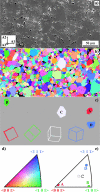Raman scattering yields cubic crystal grain orientation
- PMID: 31253866
- PMCID: PMC6599203
- DOI: 10.1038/s41598-019-45782-z
Raman scattering yields cubic crystal grain orientation
Abstract
The paper proposes a fully optical method for determination of a cubic crystal grain orientation in a sample inspected by a Raman microscope. The method is based on a universal and strong polarisation anisotropy of the Raman scattering by doubly degenerate optic phonon modes and it only requires a standard Raman microscope equipped with a polarisation analysis. Explicit formulas for the orientation of the crystal grain are derived. The feasibility of the approach is demonstrated by comparing grain orientations in a polycrystalline cubic lacunar spinel GaV4S8 determined independently using electron backscatter diffraction and Raman scattering methods.
Conflict of interest statement
The authors declare no competing interests.
Figures




References
-
- Hlinka J, Pokorny J, Karimi S, Reaney IM. Angular dispersion of oblique phonon modes in BiFeO3 from micro-Raman scattering. Phys. Rev. B. 2011;83:020101. doi: 10.1103/PhysRevB.83.020101. - DOI
-
- Borodavka F, Pokorny J, Hlinka J. Combined piezoresponse force microscopy and Raman scattering investigation of domain boundaries in BiFeO3 ceramics. Phase Transitions. 2016;89:746–751. doi: 10.1080/01411594.2016.1206544. - DOI
LinkOut - more resources
Full Text Sources

